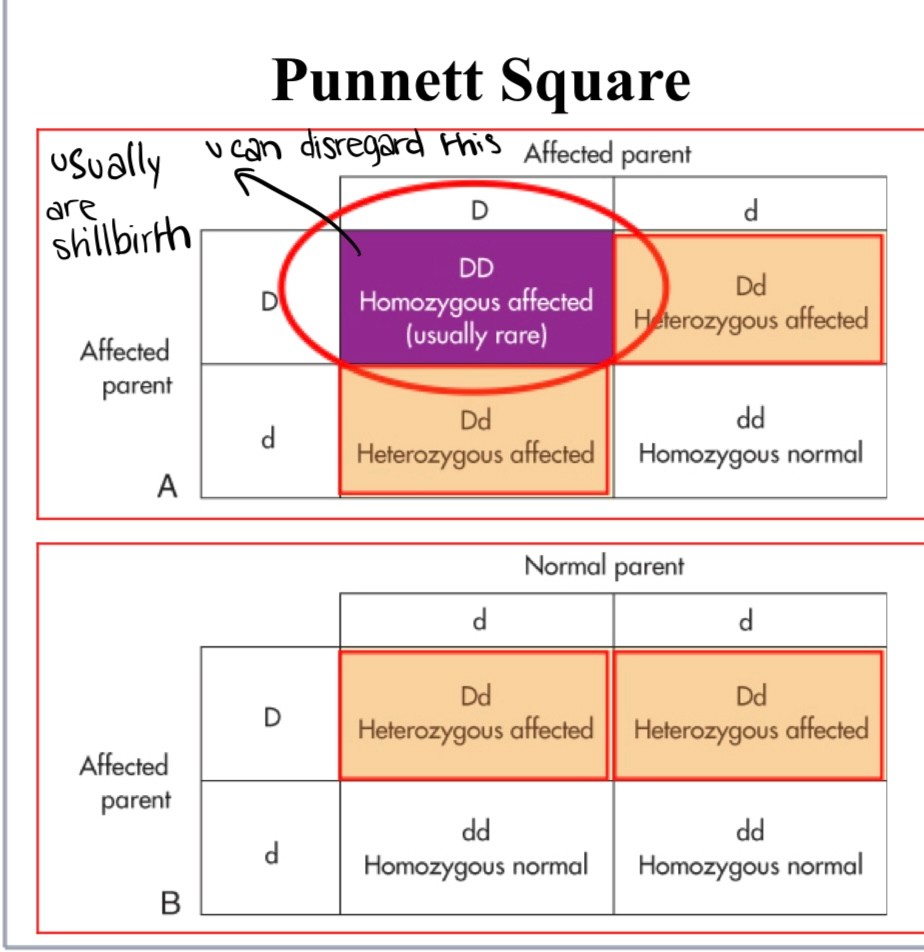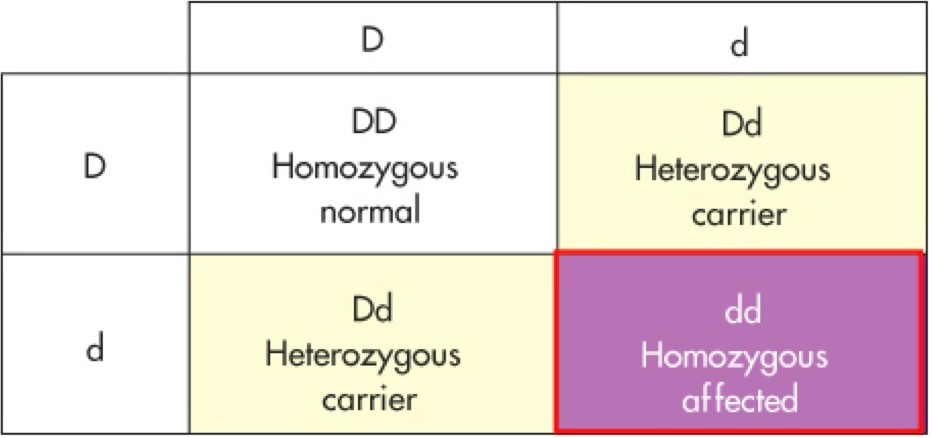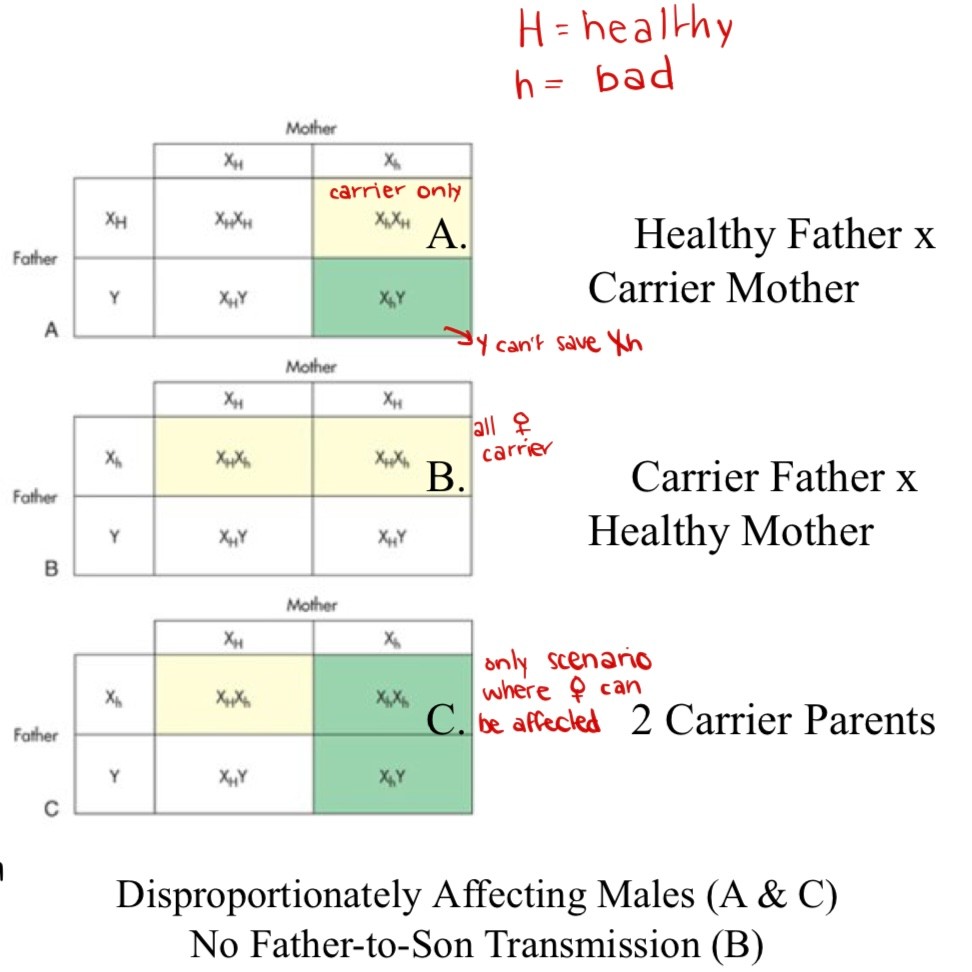-
what does DNA stand for? what is it?
deoxyribose nucleic acid
individual coding molecules, carries the genetic info for development
-
what are the nucleotide pairs? what type of bonds form between them?
A:T -> adenine / thymine
G:C -> Guanine / cytosine
hydrogen bonds form between them
-
what is a chromosome? How many pairs are there?
organized bundle of DNA
23 pairs
-
what are nucleosomes?
proteins that support DNA
-
what are genes?
protein-specific DNA sequence code -> instructions for making proteins
-
explain how a recipe book can be compared to genetics in humans
DNA is a recipe book for our cells to produce different types of proteins
Each cell has the same recipe book, but each cell will not make the same recipe
-
explain overall mechanism of gene to protein
genes go through transcription in the nucleus, they travel with mRNA to cytoplasm where the translation happens to become protein
-
what is gene transcription?
the process of making an RNA copy of a gene's DNA sequence, called mRNA
-
what is gene translation?
the decoding of instructions for making proteins
-
why does DNA replication need to happen?
when cells divide, they both need a copy of DNA
-
what are the 3 proteins and their role in DNA replication?
DNA helicase = template unzipping, they unwind the DNA
DNA polymerase = nucleotide addition + proofreading, they assemble it
DNA ligase = seals off new DNA
-
what is a DNA mutation?
any form of error in sequence
-
what are mutational hotspots?
genes with mutation frequency > normal -> genetic disorders
-
what are mutagens?
substances that increase mutation rate (radiation, alkylating agents -> chemo)
-
what are 3 protein alterations? list them in order of severity
missense mutation -> a DNA change that results in different amino acids being encoded at a particular position in the resulting protein -> switch pairings (ex: AT for GC)
nonsense mutation -> a change in DNA that causes a protein to terminate or end its translation earlier than expected -> codes for stop codon
frameshift mutation -> a genetic mutation caused by a deletion or insertion in a DNA sequence that shifts the way the sequence is read -> everything is ruined
-
what are X and Y chromosomes?
sex
XX: female
XY: male
-
is the human genome present in every single cell?
yes, but not all is used in every cell
-
what is mitosis?
a process of cell duplication, or reproduction, during which one cell gives rise to two genetically identical daughter cells
-
explain mitosis steps
1) Prophase n=4Chromatin into chromosomes, the nuclear envelope break down, chromosomes attach to spindle fibres by their centromeres.2) MetaphaseChromosomes line up along the metaphase plate (centre of the cell).3) AnaphaseSister chromatids are pulled to opposite poles of the cell.4) Telophase n =2Nuclear envelope reforms, 2 new identical cells
-
what is meiosis?
a type of cell division in sexually reproducing organisms that reduces the number of chromosomes in gametes
-
explain meiosis steps
like mitosis but happens 2 times -> 2 divisions
end result is 4 daughter cells that are not identical
-
what are chromosomal aberrations? what are 2 examples? how do they happen?
during division the structure of the chromosome is affected
polyploidy and aneuploidy
error in meiosis
-
what is polyploidy?
multiple of 23 chromosomes
ex: 3 copies instead of 1
-
what is aneuploidy?
not a multiple of 23 chromosomes
ex: trisomy 21 = 47 chromosomes (1 extra chromosomes in pair 21)
-
what usually happens when there is a chromosome aberration?
a stillborn baby -> there is too much info for it to survive
Down syndrome is rare type that is still viable
-
why is sex chromosome aneuploidy viable?
we only need one X chromosome to live
Y chromosome is so small, barely any info
-
what is turner syndrome?
loss of paternal X chromosome
characteristics: short, abnormal female genitals, exogenous estrogen for secondary sexual development
-
what is Klinefelter syndrome?
extra X chromosome
characteristics: male appearance + sterile, small testes and female breast development, increased physical + mental alterations
-
what are the 5 types of chromosome breakage>
deletion
duplicate
inversion
reciprocal translocation
-
what is deletion?
it gets deleted -> loss of info
ex: cri du chat syndrome
-
what is duplication?
gets duplicated -> too much info
ex: Huntington's disease
-
what is inversion?
2 of them switch spots, no loss no problems BUT -> if swap breaks gene it is a problem
-
what is reciprocal translocation?
sections swap from different pairs -> can lead to problems but not always
ex: chronic myeloid leukemia (CML), chromosome 9 and 22 switch sections which leads to increased cell division in blood cells
-
what is a phenotype?
outward appearance of organism, expression of trait
ex: blue or green eyes
-
what is genotype?
maternal + paternal alleles pair
ex: B - blue eyes. b - green eyes
3 possibles genotypes: BB (homozygous), Bb (heterozygous), bb
ONLY concerned with pairings of alleles
-
what are alleles?
variants of gene
ex: gene -> eye color, allele -> green
-
what is a polymorphism?
2+ alleles w/significant frequency in population
-
what is dominant vs recessive alleles?
dominant is always expressed: FF and Ff
recessive only if it is ff, not Ff
-
what is incomplete dominance?
a form of Gene interaction in which both alleles of a gene at a locus are partially expressed, often resulting in an intermediate or different phenotype
ex: red + white flower make a pink flower
-
what is codominance?
phenomenon in which two alleles are expressed to an equal degree within an organism
ex: red + white flower make red/white striped flower
AB blood type
-
what is a Punnett square?
used to map out genotypes + phenotypes
-
what is dominant inheritance ? draw Punnett square

an abnormal gene from one parent can cause disease.
2 affected parents -> 66% chance
1 affected parent -> 50% chance
ex: Huntington's disease, achondroplasia
-
what is recessive inheritance? draw Punnett square

both genes in a pair must be abnormal to cause disease
around 25% risk
parents are usually healthy carriers
IF there is incest, risk increases to 66%
-
what are 3 combinations of (se)X-linked inheritance?

healthy dad x carrier mom
carrier dad x healthy mom
2 carrier parents (only scenario where female can be affected)
-
why is color blindness more common in male?
if an X copy is bad, the other one will take over in female
male only has one X copy
-
what is incidence vs prevalence?
inheritance: # of new cases in timeframe within population -> no info on genetics
prevalence: ratio of affected individuals at specific time -> yields info on genetics
-
what are monozygotic twins? dizygotic?
identical: 1 sperm + 1 egg
fraternal: 2 sperm + 2 eggs (no more similar than siblings)
-
explain MZ and DZ twins concordance in terms of fingerprints, measles, schizophrenia and IQ? what can we conclude for each?
1. MZ 95%, 49% -> fingerprints are genetic based
2. MZ 95%, 87% -> measles are environment based
3. MZ 47%, 12% -> genetics have a bigger role, but environment has too
4. MZ 76%, 51% -> IQ is both genetics n environment
-
what is a polygene?
a characteristic, such as height or skin color, that is influenced by two or more genes
-
what are epigenetics?
how your behaviors and environment can cause changes that affect the way your genes work
doesn't change what is written in ur gene -> but how fast its reading and what chapters
modifies expression pattern of some genes
influenced by environmental factors
some epigenetic modifications can be transmitted to offspring
-
what is genomic imprinting?
only one copy of a gene in an individual is expressed, while the other copy is suppressed
imprinted -> inactive, no protein can go read there
-
what is epidermis layer role? what are 4 layers?
environmental protection: dehydration (keratinization), UV (melanin), pathogens (langerhans cells), mechanical stress (Merkel cells)
top to bottom: stratum corneum, stratum granulosum, stratum spinosum, stratum basale
-
what is epidermis continuous turnover?
it take around 30 days for dead cell to go from stratum basale up to surface to be shed
-
what is in dermis?
hair shaft, nerves, sweat + sebaceous glands, lymphatic + blood vessels, mast cells (immune)/macrophages/fibroblasts (produce collagen)
-
what is in hypodermis?
adipose tissue + blood vessels
connects skin to muscles
-
what do sebaceous glands do?
secrete sebum that prevents drying
-
what are nails and what do they do?
protective keratinized (dead cells) plates
-
what are 2 sweat glands and what do they do?
eccrine: thermoregulation
apocrine (bad smell): armpits + genitals -> unknown function
-
what are papillary capillaries and their role?
small blood vessels at surface of skin
body temp regulation
-
what do hair follicles do?
form unit w/sebaceous gland + erector pili muscle (contract if ur cold to keep u warm)
-
what are 3 types of alopecia?
male-pattern -> gradually replaced by vellum (sparse light hair)
top of head follicles = androgen sensitive
back + sides follicles = androgen insensitive
female-pattern -> progressive thinning + loss
alopecia areata -> T-cell mediated autoimmune, chronic inflammation of follicles
-
what is hirsutism?
male pattern hair growth in women -> evaluate for endocrine disorders
-
what is paronychia?
infection of cuticle, strepto or staphylococcus bacteria
moisture increases risk
painful + abscess may form
-
what is onychomycosis ?
infection of nail plate, hyperkeratotic debris within plate
yellow + elevated nail, fungal infection
-
what are 4 degrees of frostbite?
1: superficial freezing
2: full thickness freezing
3: deep: full thickness + subcutaneous freezing
4. deep: full thickness + subcutaneous freezing + gangrene (cells undergoing necrosis)
-
what causes loss of protection + hair color with age?
decrease of melanocytes + langerhan cells
-
what causes decrease of elasticity + increase wrinkling with age?
decrease in elastin, collagen and fibroblast
wrinkles is also environmental damage (UV, smoking, nutrition...)
-
what causes decrease of sensory perception with age?
decreased touch + pressure receptors
-
what causes impaired wound healing + thermoregulation with age?
decreased vasculature + immune cells
-
how do pressure ulcers occur? what are risk factors?
constant pressure occluding blood vessels -> ischemia -> increased cells necrosis
prolonged immobilization, impaired perfusion, shearing forces
-
what is the pathophysiology behind allergic contact dermatitis?
allergen contact on skin -> triggers immune cells -> T-cell activation + cytokine release -> inflammation
-
what are the manifestations of allergic contact dermatitis?
itching/swelling + erythema
-
why is there delayed hypersensitivity with allergic contact dermatitis?
time for t-cell activation + inflammatory mediators effects
-
what is allergic contact dermatitis?
a T-cell/delayed type-IV hypersensitivity reaction
immune response to harmless molecules
-
what is irritant contact dermatitis?
inflammation response to an actual injury
-
what is pathophysiology of irritant contact dermatitis?
skin barrier compromised -> exposition to irritant -> inflammation in response to injury
injury proportional to irritant concentration + exposure
-
what is psoriasis?
helper t-cell mediated autoimmune disorder
PSORS1 gene = genetic susceptibility
-
what is pathophysiology of psoriasis?
Th17/IL-23 pathway hyperactivation -> extensive/constant skin inflammation -> keratinocyte hyperplasia + increased vasculature -> plaque formation
-
what is pathophysiology of acne vulgaris?
any of 4 risk factors: hyperkeratinization, increase sebum production(increase in androgen and testosterone levels), increase proliferation of P. acnes bacteria, rupture of sebaceous follicle -> skin pore obstruction -> inflammation
-
what is acne rosacea?
possibly immune-mediated, not well understood, not associated w/ P acnes bacteria or testosterone
-
what is pathophysiology of acne rosacea?
chronic abnormal vasodilation -> erythema
-
what is discoid lupus erythematosus (DLE)?
systemic lupus w/cutaneous only manifestations
has genetic susceptibility : increased self reactive T & B cells, decreased regulatory T cells
has photosensitivity: lesions located on light exposed regions (butterfly face lesion)
can progress into SLE
-
what is pathophysiology of DLE?
UV light + altered immunity -> activation of self-reactive T & B cells -> formation of autoantibodies immune complexes (AIC) -> skin damage + vasculitis
-
what is herpes simplex? what is pathophysiology?
HSV-1 (cold sores) + HSV-2 (genital herpes) -> lesions = rash + inflamed vesicles
virus infects epithelium cells -> latency in dorsal root ganglion (hides in neurons, often in CN V) -> viral reactivation -> skin lesions
80% of population has this, easy transmission, very little have lesions, so hard to get rid of because it is always "hiding"
-
what is herpes zoster & varicella? what is pathophysiology?
varicella-zoster virus (VSZ; HSV-3) -> lesions = shingles or infected dermatome
virus infects epithelium cells -> latency in dorsal root ganglion -> viral reactivation -> skin lesions
immunocompromised are at higher risk, SUPER painful
-
what is kaposi sarcoma? what is pathophysiology? difference between classic vs AIDS form?
vascular-malignancy associated w/immunosuppresion (ex: organ transplant, AIDS, HIV)
immunosuppression -> latent HSV-8 opportunistic infection -> multifocal lesions + inflammation at blood vessels -> characteristic purple plaques + nodular lesions
classic: slow progression, affects lower extremities
AIDS: rapid progression, affects upper body, face, visceral organs
-
what is lupus? what is pathophysiology? what are 3 stages of infection?
multisystem bacterial infection by borrelia burgdoferi -> transmitted by tick bites
tick bite -> bacterial invasion of tissues -> localized erythema migrans (T-cell mediated) -> systemic spreading -> secondary erythema migrans + complications
1. localized erythema migrans - days after bite
2. spreading of illness w/neuralgias and neuritis/carditis -> weeks
3. late persistant -> can lead to encephalopathy + heart failure
-
what are some topical drug formulations?
ointements -> oil based, high absorption, dry/thick skin, bad oozing wounds
creams -> oil + water, dry inflamed skin, better for rubbing
lotions -> mostly water, alcohol/acids, good for large/hairy areas, decrease oiliness
powders -> cornstarch base, perspiring regions
pastes -> ointment + powder, occluded areas, powder increases skin adherence
foams -> shaving, quick dry no residues
gels -> cellulose/water or oil, oily skin, large/hairy areas, facials
-
what are topical glucocorticoids? give actions, potency, adverse effects, administration
anti-inflammatory + itching for many skin conditions
potency depends on concentration, formulation + area applied, absorption increased by occlusive dressing
local: increased infection risks + irritation
systemic: growth delay + adrenal suppression
occlusive dressings + large areas increase toxicity
thin films + gentle rub, avoid occlusive dressings unless told
-
what are keratolytic agents? give 2 examples
they promote shedding of superficial skin layer, used to treat skin overgrowth or abnormal thickening
salicylic acid: dissolves surface intercellular connections -> 3-6% for acne +psoriasis, 6-40% for warts
topical sulfur: promotes peeling + drying, for acne/psoriasis/dandruff, combined w/salicylic acid
-
what are 2 drugs for hair loss?
minoxidil: potent vasodilator, unknown mechanism -> delay hair loss + increase growth, hair loss resumes if discontinued
finasteride: inhibits DHT production which decreases hair shrinking -> modest hair growth, effective in 50%
-
what is considered as acne management in terms of therapeutic objectives, non pharmacological treatment (mild acne) + pharmacological treatment (more severe)?
decrease scarring, psychological burden + limit symptom duration
non-irritant soap (decrease oil), avoid vigorous scrubbing, avoid makeup/moisturizers, NOT DIET CHANGE
drugs!
mild: topical retinoids or antibiotics
moderate: antibiotics
severe: oral retinoids
-
what is general action of acne antibiotics? what are examples of topical and oral ones?
decrease P.acnes growth + inflammation
benzoyl peroxide: no resistance development but risk of anaphylactic reaction
clindamycin/erythromycin: minimal toxicity but quick resistance development
doxycycline: less resistance development, 3-6 months for benefits
-
how do topical retinoids work against acne? wrinkling? what are adverse effects?
normalize epithelial cells hyper proliferation -> unplug + inhibit blackheads
thinning of stratus corneum -> increased topical Rx absorption
not better than good skin care + sunscreen
no systemic effects only localized, increased sunburn risk
-
what is action of oral retinoids (accutane)? what are toxicities?
decrease sebum/inflammation/keratinization
nose bleeds/lip inflammation/sunburns = common
erectile dysfunction/increased blood triglycerides/depression = less
DO NOT TAKE IF PREGGO - teratogenic
drug interactions: tetracyclines + vitamin A supplements
-
what are 2 types of UV radiation?
UVB (5% total earth radiations): epidermis only -> burning/tanning/cancer
UVA (95% total earth radiations): epidermis + dermis -> photoaging, photosensitive
-
what does sunscreen protect against? what ingredient should you avoid?
sunburn, photosensitivity, photoaging, melanoma, squamous cell carcinoma
PABA + oxybenzone
-
what is SPF? which one should u use?
when exposed to UV light, time to produce redness on protected skin/time to produce redness in unprotected skin
15+

